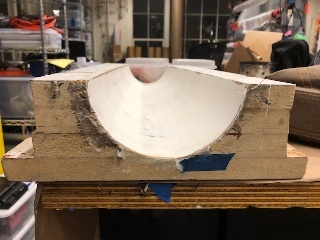Above: Hermes 1 nose cone mold (4 layers of 1" thick MDF, sanded and finished with gel coat), manufactured by Raul Largaespada.
Fiberglass Nose Cone
Required Materials
- 1" thick MDF (medium-density fiberboard)- how much???
- epoxy?
- pins (what size? length?)
- gel coat?
- fiberglass
- moar epoxx
- Partall Paste #2
- PVA (polyvinyl alcohol) Film
- Spray gun
- lubricant
- scissors
- sandpaper (400, up to 1000 and 2000 grit)
- Phenolic
- Steel
- Bolt
- Washer
- Bandsaw
- router
Overview of Nose Cone Design
Shape, materials, length, fineness ratio, tip dimensions and material, washer, bolt, method for attaching thermocouples, etc.
*remember that you need TWO halves of the mold.
Talk about mold materials used (MDF, gel coat), why fiberglass used
Manufacture Mold
- Create design of mold in Solidworks (using "Solidworks mold tools" --> helpful tutorial: https://youtu.be/yqROZFStz6c)
- Calculate how much MDF needs to be used (based on thickness, dimensions of nose cone). Make sure to account for extra area for pry slits and alignment pins.
- We want the mold to be very regular (90 degree angles) so that alignment when routing will be easier. Cut MDF using a table saw or a bandsaw (where can we find table saw?)
- Glue layers together (using what?)
- Alignment pins and pry slits? (what are pry slits? what order should this be done in? how many pins?)
Route Mold
- Download Mastercam: http://ist.mit.edu/mastercam
- Plot a path to cut the mold using Mastercam
- Go to Hobby Shop to get help from peeps
- Take notes of helpful tips and add to this Wiki article
- When routing:
- Make sure the router is routing the correct shape- pause if necessary.
- Lots of sawdust will be generated, so follow the router tip with a vacuum to get most of it.
Mold Preparation
- Sand the mold, starting with 400 grit and working up to 1000 and 2000. This will take a long time!
- Apply 5 layers of gel coat (respirator required)
Nose Cone Layup
- Cut fiberglass layers
- Mold release/lubricant (more than you think you need!)
Nose Cone Tip
